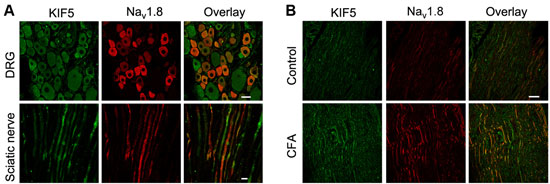Overview
- Peptide (C)EDEVAAKEGNSPGPQ, corresponding to amino acid residues 1943-1956 of rat NaV1.8 (Accession Q63554). Intracellular, C-terminus.

 Western blot analysis of rat DRG lysates:1. Anti-NaV1.8 (SCN10A) Antibody (#ASC-016), (1:200).
Western blot analysis of rat DRG lysates:1. Anti-NaV1.8 (SCN10A) Antibody (#ASC-016), (1:200).
2. Anti-NaV1.8 (SCN10A) Antibody, preincubated with Nav1.8/SCN10A Blocking Peptide (#BLP-SC016).
- Rat dorsal root ganglia (15 µg) (Tan, Z.Y. et al. (2014) J. Neurosci. 34, 7190.).
 Expression of NaV1.8 in rat DRGImmunohistochemical staining of adult rat dorsal root ganglion (DRG) using Anti-NaV1.8 (SCN10A) Antibody (#ASC-016). NaV1.8 staining (red) is cytoplasmic and the intensity varies among DRG cells. There is a partial overlap in the distribution of NaV1.8 and neurofilament 200 (green).
Expression of NaV1.8 in rat DRGImmunohistochemical staining of adult rat dorsal root ganglion (DRG) using Anti-NaV1.8 (SCN10A) Antibody (#ASC-016). NaV1.8 staining (red) is cytoplasmic and the intensity varies among DRG cells. There is a partial overlap in the distribution of NaV1.8 and neurofilament 200 (green).- Human neuromas (1:100) (Black, J.A. et al. (2008) Ann. Neurol. 64, 644.).
- Rat dorsal root ganglia (DRG) (1:500) (Belkouch, M. et al. (2011) J. Neurosci. 31, 18381.).
- Lai, J. et al. (2003) Curr. Opin. Neurobiol. 13, 291.
- Renganathan, M. et al. (2003) Brain Res. 959, 235.
- Fang, X. et al. (2002) J. Neurosci. 22, 7425.
- Wu, L. et al. (2002) Neuro. Report 13, 2547.
- Baker, M.D. and Wood, J.N. (2001) Trends Pharmacol. Sci. 22, 27.
- Fjell, J. et al. (2000) Neuro. Report 11, 199.
Voltage-gated Na+ channels (NaV) are essential for the generation of action potentials and for cell excitability.1 NaV channels are activated in response to depolarization and selectively allow flow of Na+ ions. To date, nine NaV α subunits have been cloned and named NaV1.1-1.9.2-3 The NaV channels are classified into two groups according to their sensitivity to tetrodotoxin (TTX): TTX-sensitive and TTX-resistant channels.4-5 Expression of the α subunit isoform is developmentally and tissue specific.
Two TTX-resistant NaV channels are expressed in dorsal root ganglion (DRG) neurons, NaV1.8 and NaV1.9. The NaV1.8 channel (also called SCN10A, SNS and PN3) is mainly expressed in small-diameter DRG neurons.4-6 TTX-resistant channels have been suggested to play an important role in nociceptive transmission.
Recently, involvement of NaV1.8 in multiple sclerosis (MS) was suggested due to up-regulation of both mRNA and protein in Purkinje cells of MS patients and also in animal models.6
Application key:
Species reactivity key:
Anti-NaV1.8 (SCN10A) Antibody (#ASC-016) is a highly specific antibody directed against an epitope of the rat protein. The antibody can be used in western blot, immunoprecipitation, immunocytochemistry, and immunohistochemistry applications. It has been designed to recognize NaV1.8 from rat and mouse samples.

Expression of NaV1.8 in rat DRG and sciatic nerve.Immunohistochemical staining of rat DRG and sciatic nerve using Anti-NaV1.8 (SCN10A) Antibody (#ASC-016). A. NaV1.8 (red) and KIF5B co-localize in DRG and sciatic nerve. B. NaV1.8 (red) and KIF5B expression increases following inflammation induction.Adapted from Su, Y.Y. et al. (2013) with permission of the Society for Neuroscience.
Applications
Citations
- Immunohistochemical staining of dorsal root ganglion sections. Tested in mice with Nav1.8 knockdown.
Zhu, J. et al. (2020) eLife. 9, e57656. - Western blot and immunohistochemical staining of dorsal root ganglion sections. Tested in rats treated with lentiviral vector expressing siRNA-Nav1.8.
Yan, J. et al. (2020) Pain Physician. 23, E673.
- Rat brain neurolemma lysate.
Murenzi, E. et al. (2017) Neurotoxicology 60, 260. - Rat DRG lysate (1:200).
Yan, J. et al. (2016) Eur. Spine J. 25, 177. - Rat trigeminal ganglion lysate.
Yang, K.Y. et al. (2016) J. Dent. Res. 95, 1183. - Rat DRG lysate (1:200).
Cheng, K.I. et al. (2014) Eur. J. Pain 18, 162. - Rat DRG lysate (1:200).
Hu, S. et al. (2013) Am. J. Physiol. 304, G311. - Rat colon lysates.
Hu, S. et al. (2013) Exp. Neurol. 248, 275. - Rat sciatic nerve and rat DRG (1:2000).
Su, Y.Y. et al. (2013) J. Neurosci. 33, 17884. - Rat DRG lysates (1:200).
Shen, K.F. et al. (2013) Exp. Neurol. 247, 466. - Rat DRG lysates (1:100).
Sun, W. et al. (2012) Brain 135, 359. - Rat L4-6 DRG lysates (1:200).
Yu, Y.Q. et al. (2011) PLoS ONE 6, e19865.
- Rat dorsal root ganglia (15 µg).
Tan, Z.Y. et al. (2014) J. Neurosci. 34, 7190.
- Rat DRG sections (1:300).
Qiu, F. et al. (2016) Neurochem. Res. 41, 1587. - Mouse lumbar and DRG sections (1:150).
Lu, R. et al. (2015) J. Neurosci. 35, 1125. - Rat DRG.
Cheng, K.I. et al. (2014) Eur. J. Pain 18, 162. - Rat DRG sections (1:200).
Hu, S. et al. (2013) Am. J. Physiol. 304, G311. - Rat DRG sections(1:1000).
Su, Y.Y. et al. (2013) J. Neurosci. 33, 17884. - Rat DRG sections (1:400).
Sun, W. et al. (2012) Brain 135, 359. - Rat L4-6 DRG sections (1:200).
Yu, Y.Q. et al. (2011) PLoS ONE 6, e19865. - Rat L4-6 DRG sections (1:500).
Belkouch, M. et al. (2011) J. Neurosci. 31, 18381. - Human neuromas (1:100).
Black, J.A. et al. (2008) Ann. Neurol. 64, 644.
- ND7-23 cells (1:1000).
Su, Y.Y. et al. (2013) J. Neurosci. 33, 17884. - Rat DRGs (1:200).
Shen, K.F. et al. (2013) Exp. Neurol. 247, 466. - Rat cultured DRGs (1:500).
Belkouch, M. et al. (2011) J. Neurosci. 31, 18381.
